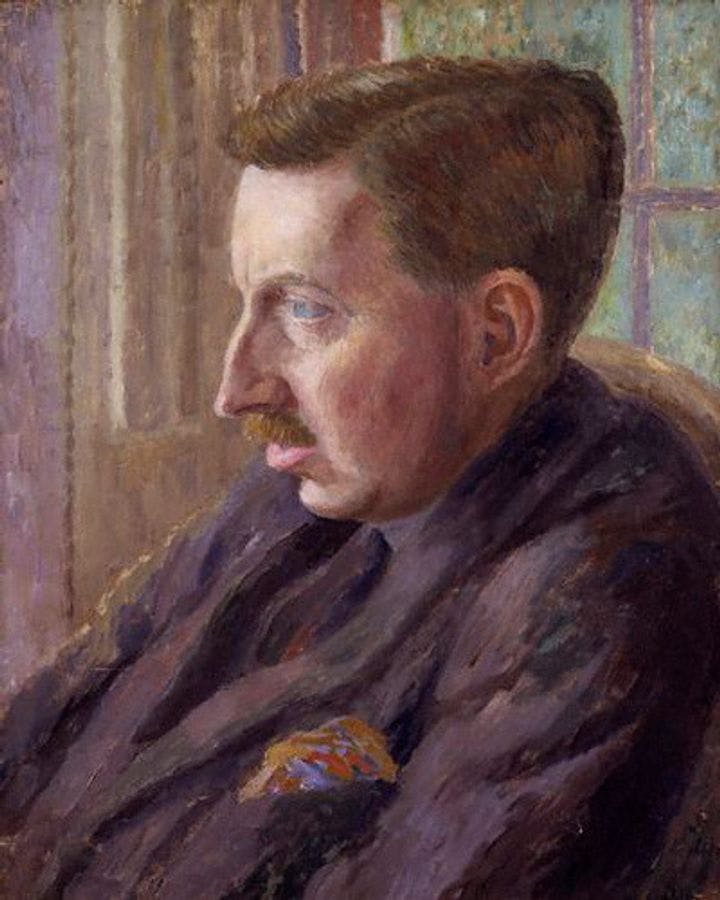Spring 2010
Morgan's End
– James Morris
With new access to archived letters and diaries we gain a fresh perspective on E. M. Forster's private life.
The British writer E. M. Forster had sex for the first time when he was 37, in 1916, on a beach in Egypt, with a convalescent soldier, after decades of dithering and yearning. By that momentous day of “parting with Respectability” (his words), Forster had already published four novels (Where Angels Fear to Tread, The Longest Journey, A Room With a View, and Howards End), all of which evaded his sexual inexperience. He had written a fifth, Maurice, that he feared to publish because of its explicitly homosexual content. Morgan, as Forster was known to friends, willed for the book’s male lovers the idealized romantic arrangement and happy ending that he sought in his own life but could not pursue publicly lest he be Reading Gaoled. So Maurice was not published until 1971, the year after Morgan’s death, and, ironic comeuppance for the dreamer, it’s the least persuasive of his novels.
The “great unrecorded history” in the title of Wendy Moffat’s biography is the roundelay of sexual approaches, evasions, couplings, swappings, and uncouplings shared over the years by Morgan and his circle of homosexual (queer but not yet officially gay) friends, lovers, acquaintances, and confidantes. “Though he burned great bonfires of ephemera,” Moffat writes, “Morgan carefully preserved the record of his gay life. Thousands of unpublished pages of letters, diaries, essays, and photographs tell the story of the life he hid from public view. . . . Only in 2008 were the final entries in his private diary, restricted from view since his death, opened to readers.” Moffat’s frank account of how Forster balanced a public self with the private self revealed in the withheld materials might seem as rude as a home invasion had the man himself not left the door ajar and gambled that someone would eventually take a boot to it.
The broad details of Forster’s life are familiar from previous biographies: fatherless childhood, a flowering in the moist male hothouse atmosphere of Cambridge, service with the International Red Cross in World War I, literary fame and international celebrity, time abroad in Italy, Greece, Egypt, India, and America. Moffat, an English professor at Dickinson College, in Carlisle, Pennsylvania, views the life from the slant of sexuality, and that makes for a necessarily straitened perspective. The problem is not Forster’s sexual orientation as such, but the primacy given it. Being homosexual may have been the central fact of Forster’s life, but it’s a fact implicated in a grand filigree of facts Moffat does not pretend to convey. They’re available elsewhere. The sexual revelations here are golden and addictive—and surely respectable, because archival.
Though late to sex, Forster made up for lost time: “By the mid-1920s, Morgan began to get the hang of the double life. In answer to a query from Joe [the author J. R. Ackerley] he totted up a full accounting of his sexual partners: 18 to Joe’s 200 or so. Morgan celebrated their variety if not their numbers.” But then, he still had a lot of years ahead of him. He moved through the 20th century in the changing company of an honor roll of gay and bisexual celebrities, among them Ackerley, Christopher Isherwood, Virginia Woolf and the Bloomsbury gang, Siegfried Sassoon, Constantine Cavafy, W. H. Auden, Paul Cadmus, Lincoln Kirstein, Glenway Westcott, Benjamin Britten, and Alfred Kinsey (why not?). Yet, he confessed, none of his “intimates” was “eminent.” The love of his life turned out to be a burly young British cop he met in 1930. It was in the cop’s home that he died 40 years later, attended by the man’s wife. The rules of attraction defy codification.
“So great and honest a writer and so humane a man” is Moffat’s judgment of Forster. One wants to believe her, though Forster emerges from this book a figure at once more complete and somewhat diminished—the price of full-to-overflowing disclosure. Though he may have chosen to record them, there are things about him that we never needed to know. For instance: “Riding in a carriage one afternoon, the mere thought that his wrist might brush the arm of the young Indian beside him made Morgan ejaculate into his trousers.” (The squeamish may here wince less at Morgan’s hair-trigger sensibilities than at the failure of Moffat’s introductory participle to brush its intended noun.) A diary entry at age 82 assures an afterlife for the day’s erection and orgasm: “The worm that never dies must have given its last wriggle this morning.” Perhaps. The man did live till 91. And oh, that worm in its salad days. When he was close to 70, on a visit to America, Forster was taken to Central Park for, in Moffat’s words, “a glorious night of casual sex.” Only connect, indeed.
* * *
Reviewed: "A Great Unrecorded History: A New Life of E. M. Forster" by Wendy Moffat, Farrar, Straus & Giroux, 2010.
Image courtesy of Wikimedia Commons
